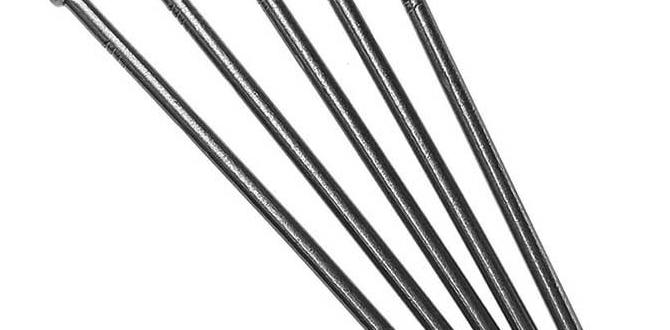Quick Summary: Detecting air leaks in your pneumatic nailer is simple! Listen for hissing, check connections, and inspect seals. Addressing leaks ensures your nailer performs efficiently, powerfully, and safely, saving you time and frustration on your DIY projects.
Hey there, fellow DIYers and woodworking enthusiasts! Jack Shaffer here, your go-to guy for all things nailers. Ever feel like your trusty pneumatic nailer is just… not quite hitting its stride? Maybe it’s taking a little longer to cycle, or the nails aren’t sinking quite as deeply as they used to. Often, the culprit behind these frustrations isn’t a major malfunction, but a sneaky little air leak. These leaks can waste precious air, make your compressor work overtime, and ultimately, lead to less-than-perfect results on your projects. But don’t you worry! In this guide, we’ll walk through exactly how to find and fix those pesky air leaks, ensuring your nailer stays in top shape. Get ready to bring back that powerful punch to your tool!
Table of Contents
Why Air Leaks Matter for Your Pneumatic Nailer
As a woodworker, your pneumatic nailer is a lifesaver. It speeds up projects, provides consistent fastening, and makes hanging trim or building furniture a real joy. But when air leaks sneak in, they can turn that joy into a headache. Think of it like a leaky faucet – a little drip, drip, drip might not seem like much, but over time, it wastes a lot of water. The same goes for your nailer and its air supply. An air leak means your tool isn’t getting the full power it needs to drive nails effectively. This can lead to inconsistent depths, missed shots, and a generally frustrating user experience. Plus, your air compressor will have to work harder and longer to maintain pressure, which isn’t great for its lifespan or your electricity bill!
Understanding how your pneumatic nailer works is key to appreciating why a tight seal is so important. These tools rely on compressed air to power their firing mechanisms. When you pull the trigger, a valve opens, and a burst of air is released behind a piston. This piston drives the nail. If there’s a leak, some of that crucial air escapes before it can do its job. This reduces the force applied to the piston, meaning less power for the nail. It’s a simple principle, but it has a big impact on performance.
The Impact of Air Leaks on Nailer Performance
- Reduced Power: Less air means less force behind the piston, leading to nails that don’t fully penetrate the wood.
- Inconsistent Firing: Leaks can cause the nailer to hesitate or misfire, disrupting your workflow.
- Increased Compressor Run Time: Your air compressor will constantly try to replenish the lost air, running longer and more frequently.
- Higher Energy Consumption: A compressor working overtime uses more electricity, adding to your costs.
- Wear and Tear: Constant cycling and struggling to maintain pressure can put extra strain on your compressor and the nailer’s internal components.
- Frustration: Ultimately, a leaky nailer just isn’t fun to use and can slow down your valuable project time.
The good news is that most air leaks in pneumatic nailers are relatively easy to detect and fix, especially for beginner DIYers. With a few simple checks, you can pinpoint the problem and get your tool back to its full potential. Let’s dive into how you can become your own nailer diagnostician!
Common Sources of Air Leaks in Pneumatic Nailers
Pneumatic nailers are generally robust tools, but like any mechanical device, they have points where air can escape. Identifying these common culprits is the first step in our leak-detection mission. Most leaks occur at connection points or involve worn-out seals. Let’s break down the usual suspects:
1. The Air Hose Connection
This is probably the most frequent place to find a leak. The point where your air hose connects to the nailer, and the point where the hose connects to the air compressor, are prime candidates for developing issues. Over time, the O-rings or seals in these connectors can become dirty, damaged, or simply worn out.
- Couplers and Plugs: If you use quick-connect couplers, check the rubber seal inside the female coupler and the condition of the male plug’s O-ring.
- Hose Integrity: Inspect the hose itself for any cracks, cuts, or abrasions, especially near the ends where it connects to fittings.
2. The Nailer’s O-Rings and Seals
Inside your nailer, a series of rubber O-rings and seals are crucial for maintaining air pressure. These components create airtight barriers that are essential for the tool’s operation. When they degrade, they can allow air to escape.
- Body Seals: The main housing of the nailer often has seals where different parts join.
- Piston Seals: The seal around the piston is vital for directing air power.
- Valve Seals: Seals around the air valve can also wear out.
These seals can be affected by age, improper storage (like in extreme temperatures), or exposure to certain chemicals. Fortunately, most nailer manufacturers offer seal and O-ring kits for common models, making replacement straightforward.
3. The Trigger Assembly
The trigger is a moving part, and its assembly often involves seals that can degrade or become obstructed. When you pull the trigger, it operates a valve that releases air. If this valve or its associated seals aren’t airtight, air can hiss out from around the trigger area.
4. The Exhaust Port
While the exhaust port is designed for air to exit, under normal operation, this happens after the nail has been driven and the tool has reset. If you hear air hissing from the exhaust while the tool is armed or between shots when it shouldn’t be venting, it could indicate an internal problem, like a valve not sealing properly.
5. Damaged Tool Housing
Less common, but still possible, is a crack or damage to the nailer’s housing itself. A significant impact could create a breach that allows air to escape. This is usually quite obvious visually.
Essential Tools for Detecting Air Leaks
You don’t need a workshop full of specialized equipment to find most air leaks. The most effective methods rely on your senses and a few common household items. Here’s what you’ll want to have on hand:
- Your Ears: The most powerful tool you have! The audible hiss of escaping air is often the first sign.
- Your Eyes: Visual inspection is crucial for identifying cracks, damage, or loose connections.
- Soapy Water: A mix of dish soap and water in a spray bottle or small container is your best friend for pinpointing leaks.
- A Rag or Paper Towels: For cleaning up spills and drying off components.
- (Optional) A Small Flathead Screwdriver or Pry Tool: For gently prying apart certain components or examining seals more closely, but be very careful not to cause damage.
Remember, safety first! Always disconnect the air supply to your nailer before you start any inspection or maintenance. You don’t want an accidental discharge while you’re poking around.
Step-by-Step Guide: How to Detect Air Leaks
Let’s get your nailer checked out! This process is designed to be beginner-friendly. We’ll go from the most common leak sources to the less obvious ones.
Step 1: Disconnect and Depressurize
This is the most important safety step. Before you do anything else, disconnect the air hose from your nailer. If there’s any residual air pressure in the tool, press the trigger (without the hose attached!) to release it. You should hear the air escape and then silence. Never work on a pressurized tool.
Step 2: Visual Inspection of Connections
Start at the most common points of failure: the connections. Look closely at:
- Nailer Air Inlet: Inspect the fitting where the air hose connects to the nailer. Is it bent, cracked, or loose?
- Coupler and Plug: If you’re using a quick-connect system, examine both the female coupler and the male plug. Is the rubber seal inside the coupler intact and free of debris? Is the O-ring on the plug in good condition?
- Air Hose: Check the entire length of the air hose for any visible damage like cuts, kinks, or bulges. Pay special attention to the areas near the fittings at both ends.
Step 3: The Soapy Water Test (The Most Effective Method)
This is where the soapy water comes in. It’s a simple but incredibly effective way to see exactly where air is escaping. You’ll need to pressurize your system for this, so ensure your air compressor is connected and running, but not attached to the nailer itself for this part of the test if you suspect the hose connection. If you’re confident the hose connection is sound, you can proceed with the nailer attached.
Testing the Hose and Connections:
- Connect the air hose to the compressor.
- Spray a generous amount of soapy water onto the coupler, plug, and the first few inches of the hose.
- Watch closely. If there are any bubbles forming where there shouldn’t be, you’ve found a leak!
What to look for: Small bubbles will appear and grow as air escapes through the leak. If you see continuous bubbling, you’ve got a problem. Common issues here include worn O-rings on the plug, damaged seals in the coupler, or a compromised hose fitting.
Testing the Nailer:
- With the air compressor turned off and the nailer disconnected, apply a bit of soapy water around the nailer’s air inlet fitting.
- Connect the pressurized air hose to the fitting. Again, make sure the compressor is running and supplying air.
- Carefully spray soapy water around the air inlet on the nailer itself.
- Listen for any hissing and watch for bubbles forming around the inlet or any seams on the nailer’s body near the inlet.
Note: For this test, it’s best to have the tool pressurized but keep it pointed away from you and do not engage the trigger. You just want to check for passive leaks.
Step 4: Inspecting Internal Seals and Components (If Necessary)
If the external connections and the air inlet seem fine, the leak might be internal. This often requires a bit more disassembly, but for many common nailers, it’s still manageable for a beginner. Always refer to your nailer’s specific manual for disassembly and reassembly instructions. A quick internet search for “[Your Nailer Model] manual” or “[Your Nailer Model] O-ring replacement” can be very helpful.
Common internal leak points and how to check:
- Trigger Assembly: With the air disconnected, have a listen around the trigger area. Sometimes, debris can get lodged in the trigger mechanism, preventing a seal. If you suspect an issue here, you might need to remove the trigger assembly according to your manual. You can then check the seals or O-rings associated with the valve controlled by the trigger. Soapy water can also be applied to this area while the tool is pressurized (with extreme caution and by pointing the tool away from yourself and others) if you can isolate that specific area.
- Body Seams: Many nailers are made of two halves screwed together. Apply soapy water to these seams while the tool is pressurized. A leak here might indicate a failed gasket or O-ring between the body halves which is often replaced when doing a general tune-up.
- Exhaust Port: While the tool is pressurized and “armed” (but don’t press the trigger yet!), listen closely to the exhaust port. A light puff of air as the tool cycles is normal. A constant hiss or a strong blast of air when it shouldn’t be firing indicates a problem, typically with the main valve or piston seals.
Step 5: Testing the Air Compressor Regulator and Hose Fittings
While less likely to be the nailer’s fault, sometimes issues at the compressor or in the longer run of the hose can mimic nailer leaks. Ensure your compressor’s regulator is set correctly and isn’t leaking from its own fitting.
A good source for understanding pneumatic systems is the NIOSH publication on the safe use of pneumatic tools, which covers principles of compressed air systems.
Quick Tip: If you have multiple tools, try connecting a different tool to the same hose and compressor. If the other tool works fine, the leak is almost certainly in your original nailer or the hose. If the other tool also performs poorly, the issue might be with the compressor or the main hose connection at the compressor.
“`html
| Symptom | Possible Cause | How to Check |
|---|---|---|
| Nailer fires weakly or not at all. | Major air leak in hose connection, internal seal, or valve. | Use soapy water test on all connections. Listen for hissing. Check internal O-rings/seals. |
| Constant hissing sound from the nailer. | Leaking valve stem, piston seal, or body seal. | Apply soapy water to trigger area, body seams, and exhaust port (while pressurized, carefully). |
| Air leaks from couplery/plug connection. | Worn O-ring on plug, damaged coupler seal, debris in coupler. | Visual inspection, soapy water test on coupler and plug. |
| Nailer takes an unusually long time to reset. | Minor internal leak, possibly piston seal or valve seal. | Soapy water on body seams and around piston area (often requires partial disassembly). |
| Compressor runs constantly. | Any significant air leak in the system (nailer, hose, or compressor fitting). | Systematic leak detection starting from nailer, then hose, then compressor. |
“`
Fixing Common Air Leaks
Once you’ve found the leak, fixing it is usually straightforward. Here are the common remedies:
1. Tighten or Replace Connections
If the leak is at the air hose connection to the nailer or compressor:
- Tighten: Sometimes, a connection just needs a good snugging up. Use a wrench if necessary, but don’t overtighten, especially on plastic fittings.
- Replace O-Rings/Seals: The most common fix! For quick-connect couplers and hose plugs, inspect the rubber O-rings. If they look worn, cracked, or deformed, replace them with new ones of the correct size. These are inexpensive and readily available at hardware stores. You can also buy replacement seals for your nailer’s air inlet fitting specifically.
- Replace Couplers/Plugs: If the coupler body is damaged or the plug threads are stripped, it’s time to replace the entire component.
2. Replace Internal O-Rings and Seals
If you’ve identified an internal leak (e.g., from body seams, the trigger, or exhaust), you’ll likely need to replace internal seals or O-rings. This is where your nailer’s manual is your best friend.
- Get the Right Kit: Purchase an


